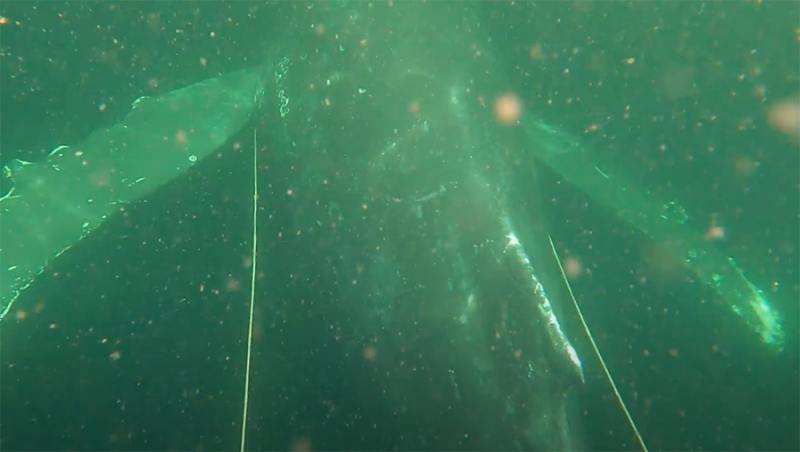The call came in to NOAA’s Alaska Marine Mammal Stranding Network 24-hour hotline the morning of July 19. A whale-watching company near Ketchikan had spotted a humpback whale entangled in line and dragging unmarked buoys. NOAA’s Office of Law Enforcement in Ketchikan responded, verified the whale’s location in Blank Inlet on the south side of Gravina Island, and monitored the entangled whale. The NOAA Large Whale Entanglement Response Program at the Alaska Regional Office in Juneau reached out to the Metlakatla Indian Community Department of Fish and Wildlife (DFW).
“When we receive a report of an entangled whale, we immediately start thinking about the trained and authorized responders who are closest to the location,” said NOAA Alaska Large Whale Entanglement Response Coordinator Sadie Wright.
In this case, the Metlakatla Indian Community had done a lot to be prepared to safely respond to entangled whales. Metlakatla’s DFW had seen a need years ago to have responders in their community trained to use specialized equipment to disentangle whales. “They emphasize personal safety, and work hard to help whales while keeping their team and their community safe,” Wright said.
The Metlakatla team had participated in NOAA Large Whale Entanglement Response program trainings in the past and had recently participated in a refresher training. Wright said, “We knew they were a terrific team who had the right skills and right equipment.”
The group of trained and authorized large whale entanglement responders at the Metlakatla DFW was perfectly positioned to assist the entangled humpback whale in Blank Inlet.
Dustin Winter, DFW Director, coordinated his team, including Kevyn McKeehan, Spencer Guthrie, and Gabe Nathen, for the entanglement response. They met NOAA’s Law Enforcement team at the whale’s location. They were able to gather underwater video that showed the whale was caught through the mouth by a thick line, and dragging unmarked buoys behind it.
- Alaska Whale Foundation
- NOAA’s Hawaiian Islands Humpback Whale National Marine Sanctuary
- NOAA Fisheries Alaska Large Whale Entanglement Response
Using the video footage and based on the whale’s behavior, they developed an action plan.
“The underwater video was important in our assessment of the entanglement and development of an action plan,” said Wright. “The video allowed the team to determine which line needed to be cut.”
Late in the evening, the Metlakatla team was able to use a cutting grapple to cut the line coming from the left side of the whale’s mouth. Sometimes it takes time for a whale to wiggle free once a critical cut is made, and it just wasn’t immediately obvious if the whale would swim free of the entanglement.
“The guys waited and watched until just before dark. They went back out the next morning to find that the blades did the job overnight as the whale was moving about,” said Winter. “They saw the likely whale in the same area and confirmed that the whale was free from the gear. They found the buoy and gear drifting in the location from the night before, and brought the gear home.”
Winter noted that “the DFW crew did a great job making sure that personal safety was the chief concern. We keep the gear and other essentials in a location to essentially grab and go. The guys were ready to respond very quickly.”
First Responders Critical
Trained first responders are essential in the response network and provide key details to assist with entanglement response. The local whale-watching community assisted by reaching out to NOAA’s stranding response network to report this entangled whale. They provided its location, the direction it was headed, and information about the material entangling the whale.
Another useful step is to take photos and video of the whale (collected from a safe and legal distance of more than 100 yards) to provide to the NOAA response team. This documentation enables responders to proceed effectively and determine if the situation is life-threatening.
Communication was key. NOAA’s Law Enforcement officers Fred Burk and Camden Marshall stayed with the whale and relayed information between the Juneau office and the Metlakatla team. They pointed the response team to the entangled whale’s location. NOAA’s Large Whale Entanglement Program’s training and consultation with advanced responders ensured the Metlakatla team’s efforts to disentangle the humpback whale were safe and successful.
“This response is an example of multiple trained teams working collaboratively to safely remove a life threatening entanglement from a humpback whale,” said Wright. “It is such a relief knowing that this whale will have a chance to migrate somewhere warm this winter, as most humpbacks in Southeast Alaska do. This is a success story for the whale as well as for the authorized crew who were proactive in getting training in Large Whale Entanglement Response.”
Introductory Responder Courses
If you see an entangled whale, do not approach it. Contact experts who have the training and specialized equipment to respond. Getting too close to a very large and likely distressed animal can be dangerous—even life threatening. Entangled whales frequently avoid boats after repeated close encounters, making disentanglement efforts even more difficult. Cutting visible gear off can actually make things worse, so it’s best to keep your distance and leave it to the experts.
To help an entangled whale, call NOAA’s 24/7 entanglement hotline at (877) 9-AKR-PRD or (877) 925-7773; or hail the U.S. Coast Guard on VHF Channel 16 and they will relay the report.
If you’re interested in learning more about becoming a first responder, take the online training developed by NOAA in partnership with The Nature Conservancy. It will teach you how to more effectively document and communicate with NOAA to help free entangled whales. These reports are the best way to help the animal. The information gained also helps us better understand entanglements and how to reduce entanglements and their impacts in the future.




